 The Centennial Good Shepherd Staff visited Isabela Region and was received by the Good Shepherd Sisters, mission partners, religious, priests and people served on June 8, 2012.
The Centennial Good Shepherd Staff visited Isabela Region and was received by the Good Shepherd Sisters, mission partners, religious, priests and people served on June 8, 2012.
Representatives of the Good Shepherd Sisters in Mindanao -- Sr. Virgo Espineda, Sr. Francia Blando handed over the Centennial Staff to the Good Shepherd Sisters of Isabela, led by Sr. Minela Alvarez.
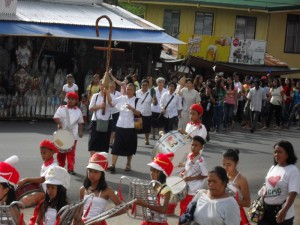 A Eucharistic Celebration was held at the Shrine of Our Lady of the Visitation (Our Lady of Guibang) adjacent the convent. Sr. M. Cecilia Torres, province leader and Sisters assigned through the years in Isabela and from various communiteis also graced the occasion. A short program followed.
A Eucharistic Celebration was held at the Shrine of Our Lady of the Visitation (Our Lady of Guibang) adjacent the convent. Sr. M. Cecilia Torres, province leader and Sisters assigned through the years in Isabela and from various communiteis also graced the occasion. A short program followed.
Rev. Fathers, Rev. Sisters, Local Government Officials, Brothers in Sisters in Christ,
To close the 100th years of presence of the Religious of the Good Shepherd in the Philippines, it is good to sing a song of thanksgiving to God who is ruler of our destinies and Lord of history. And what better way to do it than celebrating together the Eucharist of our Lord and Savior Jesus Christ.
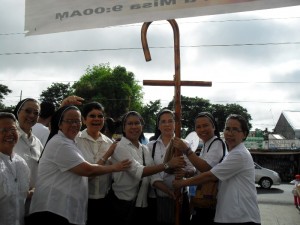 Compared to eternity, a Hundred (100) years may comprise just a very short span of time. But these same years carry within them the memories of human effort and human strivings. And we know that life is rendered meaningful because of memories. We are bound together across generations, across time and space, because of the memories we hold dear among us.
Compared to eternity, a Hundred (100) years may comprise just a very short span of time. But these same years carry within them the memories of human effort and human strivings. And we know that life is rendered meaningful because of memories. We are bound together across generations, across time and space, because of the memories we hold dear among us.
I hope I can reflect the truth of the events of these hundred years and not “edit” them to suit my own “reading” instead of looking at them from the perspective of God. Let me just begin by a simple observation that our life and salvation is enclosed between the dynamics of remembering and forgetting. To remember is to embrace life and grace; while to forget is to invite disaster and death.
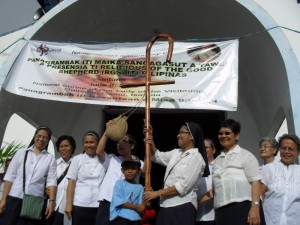 In other words, our present life gains meaning and significance when we are able to connect it with the larger horizon of history which - from our Christian perspective - is also the history of salvation. In our Christian language of tradition, we speak of anamnesis and amnesia. Between these two realities, there mediates the reality of human relationships and connectedness to a wide range of other realities. Without relationships, without this connectedness, our existence loses direction and ends in paralysis, that is, in frenetic activity without success or significance.
In other words, our present life gains meaning and significance when we are able to connect it with the larger horizon of history which - from our Christian perspective - is also the history of salvation. In our Christian language of tradition, we speak of anamnesis and amnesia. Between these two realities, there mediates the reality of human relationships and connectedness to a wide range of other realities. Without relationships, without this connectedness, our existence loses direction and ends in paralysis, that is, in frenetic activity without success or significance.
In the end, it boils down to the simple question: How much love did I show in my own life? As Jesus could really challenge His disciples in today’s Gospel “As the Father has loved me, so I have loved you… This is my commandment: love one another as I have loved you.”
 To love God and neighbor is an old commandment that we may find in many of the sacred books of great religions and especially in the Old Testament. But Jesus puts a new twist to this by saying “as I have loved you.” The identity of Jesus is put on the line. From now on, He is the standard by which our love will be judged so He could say “a new commandment I give you.”
To love God and neighbor is an old commandment that we may find in many of the sacred books of great religions and especially in the Old Testament. But Jesus puts a new twist to this by saying “as I have loved you.” The identity of Jesus is put on the line. From now on, He is the standard by which our love will be judged so He could say “a new commandment I give you.”
It is also for us to say, how much have I experienced the Love of God in my own life and then reflect it in my behavior so that others may also experience in my flesh and blood the incarnated love of God for his creation. Have I accepted the role that God has chosen me for, in the words of the prophet Ezechiel in our first reading today “… when in their sight I prove my holiness through you.”
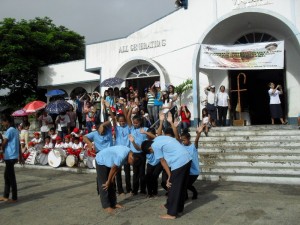 Only when I can affirm this could I begin to “embrace [the] challenges of weaving webs of compassion In order to [continue] forging hope” in the crucible of selfless service. [I realize I have “edited” a little the theme of this celebration! hehehe]
Only when I can affirm this could I begin to “embrace [the] challenges of weaving webs of compassion In order to [continue] forging hope” in the crucible of selfless service. [I realize I have “edited” a little the theme of this celebration! hehehe]
After so many years, we might be able to gauge the teleological character of all living realities, including institutions such as a religious province. We can read the historical records of our forebears and admire the situations they had to face so that, (as a way of saying) we stand today on the shoulders of those great women of vision who started this adventure more than a hundred years ago.
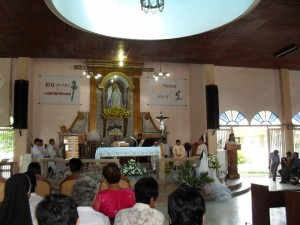 I say “more than a hundred” because we have to connect with the history of the Order of our Lady of Charity founded by St. John Eudes in 1641. This community flourished until 1814 when Rose Virginie Pelletier joined the Order and took the name Mary Euphrasia. Some years later, in 1829, she formed a contemplative community in Angers in a house called “The Good Shepherd” under the patronage of St. Mary Magdalene. The community’s specific orientation was prayer and conversion. This group developed a Constitution by 1831 that was approved by Bishop Charles Montault in 1834. The next year, in 1835, a Generalate was established and approved; and this approval established a congregation distinct now from the Our Lady of Charity and was called “Our Lady of Charity of the Good Shepherd of Angers.” When Mary Euphrasia died in April 24, 1868, the community had 110 houses spread out in the world. Mary Euphrasia was entered into the calendar of saints on the Church on May 9, 1940.
I say “more than a hundred” because we have to connect with the history of the Order of our Lady of Charity founded by St. John Eudes in 1641. This community flourished until 1814 when Rose Virginie Pelletier joined the Order and took the name Mary Euphrasia. Some years later, in 1829, she formed a contemplative community in Angers in a house called “The Good Shepherd” under the patronage of St. Mary Magdalene. The community’s specific orientation was prayer and conversion. This group developed a Constitution by 1831 that was approved by Bishop Charles Montault in 1834. The next year, in 1835, a Generalate was established and approved; and this approval established a congregation distinct now from the Our Lady of Charity and was called “Our Lady of Charity of the Good Shepherd of Angers.” When Mary Euphrasia died in April 24, 1868, the community had 110 houses spread out in the world. Mary Euphrasia was entered into the calendar of saints on the Church on May 9, 1940.
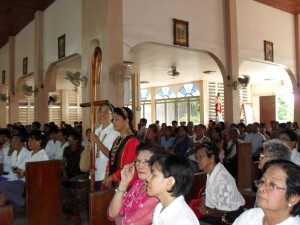 At the 1985 Congregational Chapter, the “of Angers” was dropped from the title so that the official name of the congregation became “Our Lady of Charity of the Good Shepherd” to reflect its internationality.
At the 1985 Congregational Chapter, the “of Angers” was dropped from the title so that the official name of the congregation became “Our Lady of Charity of the Good Shepherd” to reflect its internationality.
The Province, as it is today, grew from its small beginnings with the coming of the first Irish missionaries of the RGS from Myanmar in 1912. I do not know whether they followed the routes of our mythical Malay ancestors and settled in the western shores of Batangan (today Batangas) and founded the first educational institution dedicated to “... young students who needed a Shepherd’s care.”
A short run down of these hundred years would bring us to a fixed point when the Philippines was declared a Province independent from its nurturing mother-Province of Ireland (?).
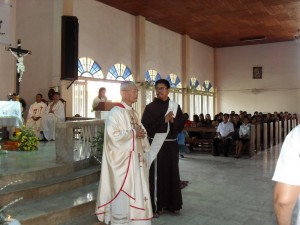 In those days, we could count: (Statistics)
In those days, we could count: (Statistics)
It looked so frail at the outset, to be sure; but simply because working earnestly for local vocations began its rootedness in the colors and voices of our people.
The life of the Sisters then was focused on the missionary work in and around urban settings.
Providence has ways to disturb our complacency so that we do not forget the challenge of our calling that flows from one of the “classics” of our spirituality. That spirit residing in the depths of our hearts will be given direction and consistency in the charismatic life of our foundation. “St. Mary Euphrasia saw God’s tender mercy in the face of Jesus, the Good Shepherd. In profound respect for each person, in complete reliance on God, she nourished this trust by her love for the Eucharist and in the contemplation of the deep and full love of the hearts of Jesus and Mary. She was a model of discipleship so that the words she uttered a centuries ago still ring true for us in this Third Millenium: “What are we doing in this world? Why are we here if not to contribute to the salvation of our brothers and sisters?”
Those were words that inspired the expansion of the Congregation into Isabela in the early days of the diocese of Ilagan. Within the first decade of the diocese, the first RGS Sister set foot in Isabela at the geographical center [the heart we may say] of the civil province: in San Mariano. You can read the chronicle of those beginning in a write-up entitled “History of the Isabela Community” most especially in the harrowing years of the Marcos dictatorship.
What does the Province look like at the end of a hundred years – from 1912 to 2012? What is its configuration?
Bare statistics do not mention the many other big and small events, the bitter and the sweet, the triumphs and the failures that took place to mark each of these hundred years of history in the Philippines and almost 37 years in Isabela.
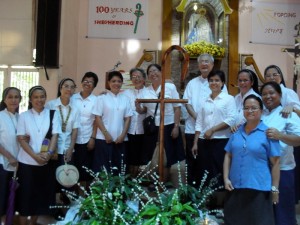 Perhaps, another chapter in the history of the Congregation in the Philippines would have to be written to reflect the images of life that make this celebration worth the time and effort in its preparation.
Perhaps, another chapter in the history of the Congregation in the Philippines would have to be written to reflect the images of life that make this celebration worth the time and effort in its preparation.
I already mentioned the anamnesis – the memorial that “re-presents” an event that took place in a particular segment of time. It is being continued today and re-lived (made to come alive) every time it is recalled and celebrated. Jesus said: “Do this as a memorial of Me.”
Thus, to remember is to make present. And, we already said, it is just a “law” in life that we are bound together by memories. And these bonds are enduring far even beyond death, so that we can remember those who have gone before us – the Irish missionaries - and feel solidarity with them.
And the opposite is amnesia – the loss of memory which is really also a loss of identity. And we hope that it will never befall us. For anyone afflicted with amnesia forgets who he/she is, forgets others, most painfully those who love and are loved. To be an amnesiac is to be “dead” to the dynamics of life and the totality of experience.
It is not at all surprising that one of the complaints of God against the people He had chosen and led out of slavery is precisely that they have forgotten what He had done for them and have become unmindful of His mercies. They have forgotten their covenant, their commitments, their own promise of faithfulness.
Therefore, the challenge of remembering is a challenge to renewal and to conversion. It is a dare to hope for a re-commitment to our ideals that we made when we pledged our troth to serve the Lord who chose us from all eternity “to be holy and blameless in His sight” (Eph 1:4).
Our Blessed Mother Mary, in whose shrine we are gathered in this celebration, whom we venerate and under whose patronage we have entrusted ourselves, is a model of thanksgiving by declaring her gratitude to God for “the great things He has done” in her favor because it is He who keeps “remembering His mercies forever.”
The usual cliché question would ask: What of the next hundred years? I do not know.
But … Let me hark back to another image that may set the standard of our celebration. After forty years in the desert and at the eve of entering the Promised Land which was a new chapter in the life of the Wanderers, the book of Deuteronomy gives us these words of the great leader Moses: “Remember how for forty years now the Lord, your God, has directed all your journeying in the desert…”(Deut 8:2) “Be careful not to forget the Lord, your God, by neglecting His commandments and decrees and statutes…”8:11) “…lest, when you have eaten your fill, and have built fine houses and lived in them, and have increased … your silver and gold, and all your property, you then become haughty of heart and unmindful of the Lord…” (12-14). And “… you might say to yourself, ‘It is my own power and the strength of my own hand that has obtained me this wealth’. Remember then, it is the Lord… But if you forget the Lord, your God, and follow other gods, serving and worshipping them… you will perish utterly.” (8:17-19).
Moses goes on farther to say, “Here then I have today set before you life and prosperity, death and doom. If you obey the commandments of the Lord, your God … loving Him and walking in His ways, and keeping His commandments, statutes and decrees, you will live and grow numerous, and the Lord your God will bless you … If, however, you turn your hearts and will not listen... I tell you now that you will certainly perish…”
And God confirms this challenge by affirming: “I call on heaven and earth today to witness …; I have set before you life and death, the blessing and the curse. Choose life.” (Deut 30:15-19).
